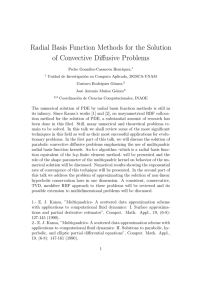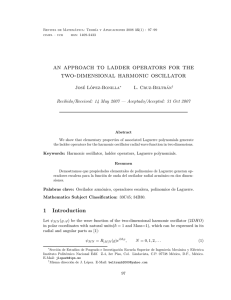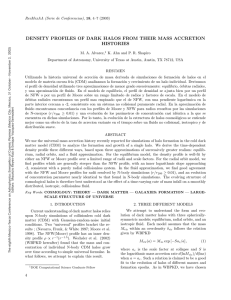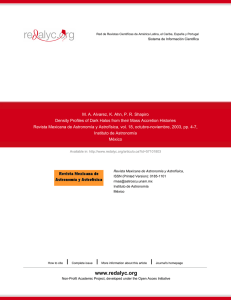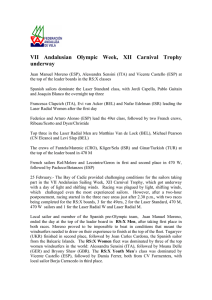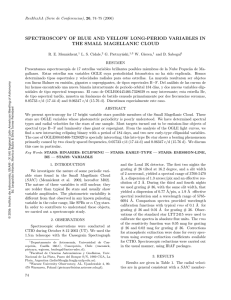new radial systems of dark globules
Anuncio
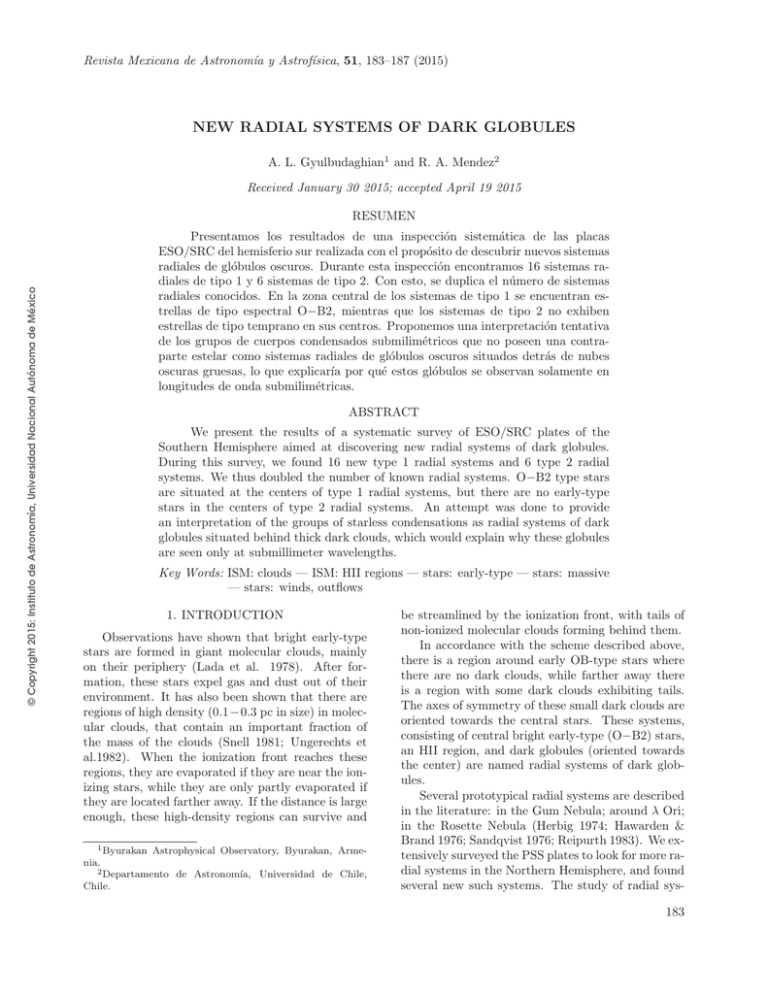
Revista Mexicana de Astronomı́a y Astrofı́sica, 51, 183–187 (2015) NEW RADIAL SYSTEMS OF DARK GLOBULES A. L. Gyulbudaghian1 and R. A. Mendez2 Received January 30 2015; accepted April 19 2015 © Copyright 2015: Instituto de Astronomía, Universidad Nacional Autónoma de México RESUMEN Presentamos los resultados de una inspección sistemática de las placas ESO/SRC del hemisferio sur realizada con el propósito de descubrir nuevos sistemas radiales de glóbulos oscuros. Durante esta inspección encontramos 16 sistemas radiales de tipo 1 y 6 sistemas de tipo 2. Con esto, se duplica el número de sistemas radiales conocidos. En la zona central de los sistemas de tipo 1 se encuentran estrellas de tipo espectral O−B2, mientras que los sistemas de tipo 2 no exhiben estrellas de tipo temprano en sus centros. Proponemos una interpretación tentativa de los grupos de cuerpos condensados submilimétricos que no poseen una contraparte estelar como sistemas radiales de glóbulos oscuros situados detrás de nubes oscuras gruesas, lo que explicarı́a por qué estos glóbulos se observan solamente en longitudes de onda submilimétricas. ABSTRACT We present the results of a systematic survey of ESO/SRC plates of the Southern Hemisphere aimed at discovering new radial systems of dark globules. During this survey, we found 16 new type 1 radial systems and 6 type 2 radial systems. We thus doubled the number of known radial systems. O−B2 type stars are situated at the centers of type 1 radial systems, but there are no early-type stars in the centers of type 2 radial systems. An attempt was done to provide an interpretation of the groups of starless condensations as radial systems of dark globules situated behind thick dark clouds, which would explain why these globules are seen only at submillimeter wavelengths. Key Words: ISM: clouds — ISM: HII regions — stars: early-type — stars: massive — stars: winds, outflows 1. INTRODUCTION Observations have shown that bright early-type stars are formed in giant molecular clouds, mainly on their periphery (Lada et al. 1978). After formation, these stars expel gas and dust out of their environment. It has also been shown that there are regions of high density (0.1−0.3 pc in size) in molecular clouds, that contain an important fraction of the mass of the clouds (Snell 1981; Ungerechts et al.1982). When the ionization front reaches these regions, they are evaporated if they are near the ionizing stars, while they are only partly evaporated if they are located farther away. If the distance is large enough, these high-density regions can survive and 1 Byurakan Astrophysical Observatory, Byurakan, Arme- nia. 2 Departamento de Astronomı́a, Universidad de Chile, Chile. be streamlined by the ionization front, with tails of non-ionized molecular clouds forming behind them. In accordance with the scheme described above, there is a region around early OB-type stars where there are no dark clouds, while farther away there is a region with some dark clouds exhibiting tails. The axes of symmetry of these small dark clouds are oriented towards the central stars. These systems, consisting of central bright early-type (O−B2) stars, an HII region, and dark globules (oriented towards the center) are named radial systems of dark globules. Several prototypical radial systems are described in the literature: in the Gum Nebula; around λ Ori; in the Rosette Nebula (Herbig 1974; Hawarden & Brand 1976; Sandqvist 1976; Reipurth 1983). We extensively surveyed the PSS plates to look for more radial systems in the Northern Hemisphere, and found several new such systems. The study of radial sys183 184 GYULBUDAGHIAN & MENDEZ TABLE 1 © Copyright 2015: Instituto de Astronomía, Universidad Nacional Autónoma de México TYPE I RADIAL SYSTEMS OF DARK GLOBULES IN THE SOUTHERN HEMISPHERE ID 1 2 3 4 5 6 7 8 9 10 11 12 13 14 RA (J2000) 08:39:09.50 08:45:21.74 10:37:53.00 16:40:15.81 16:57:27.61 17:20:16.35 17:24:46.54 17:25:38.02 17:31:57.17 18:02:45.36 18:04:37.48 18:09:24.26 18:17:47.09 18:19:01.7 DEC (J2000) -40:25:09 -41:14:14 -58:37:57 -48:43:15 -40:21:23 -35:45:53 -34:10:02 -34:14:50 -31:41:58 -23:01:00 -24:17:02 -23:50:12 -19:36:04 -18:15:12 Plate # 313 313 128 226 332 392 392 392 454 521 521 521 590 590 tems is important to clarify the evolutionary status of molecular clouds and OB stars. We found 17 type 1 radial systems and 6 type 2 radial systems (Gyulbudaghian & Akopyan 1990). It is possible to distinguish two types of radial systems: Type 1 radial systems, associated with an HII region, with O-type or, more rarely, early B-type stars, located in the center of such systems.On the other hand type 2 radial systems are not associated with HII regions, and in the center of these systems there are stars of spectral type later than B2. Type 2 radial systems can be associated with HI clouds or can have no noticeable amount of HI. It is assumed that in type 2 systems, the HII region is transformed into an HI cloud due to the weakening of the central stars, or is dissipated under the influence of the strong stellar wind and/or strong radiation field emanating from the central stars (Gyulbudaghian 1993). The dissipation of the HI cloud, or even of the initial HII region, could also be due to a supernova explosion taking place near the radial system. The distribution of HI in type 2 systems has been studied using the results of the surveys by Weaver & Williams (1973, 1974). 2. RESULTS OF THE SURVEY OF THE SOUTHERN PRINTS In this paper we report on a systematic eyeguided inspection of high-quality film copies of ESO (B), (R), ESO/SRC J and EJ plates (collectively HD HD 73882 Cr 197-22 HD 92206 HD 150136 HD 152723 Pismis 24-1 Pismis 24-1 Pismis 24-1 HD 159176 HD 164492 HD 164740 HD 166107 HD 167815 ··· Spectral Type O9III B2V O6 O6+O5V O7III O3.5I O3.5I OIII O6vE O7.5III O7.5V B2V B1/B2III ··· V 7.26 9.85 8.79 5.67 7.24 10.59 10.59 11.84 5.73 7.63 9.10 7.97 7.59 ··· called “prints” from here on) that aimed to find new type 1 and type 2 radial systems of dark globules in the Southern Hemisphere. As a result of this survey, we found 14 type 1 radial systems and 6 type 2 radial systems. The basic data about the radial systems found in this survey are summarized in Table 1 (type 1 radial systems) and Table 2 (type 2 radial systems). In Table 1, Column 1 shows the sequential identification number of each system; Columns 2 and 3 show the coordinates of the central part of the radial system; Column 4 shows the number of the plate on which the radial system was discovered; Column 5 shows the name of the most prominent central star, while the spectral type of that star is indicated in Column 6. Finally, Column 7 shows the V magnitude of the central star. In Table 2, Column 1 shows the sequential number of the radial system, Columns 2 and 3 show the approximate coordinates of the center of the system, and Column 4 shows the number of the plate on which the radial system was discovered. Object ID=3 (marked with an asterisk in the Table) has been included in the list of type 2 systems because even though it has a bright star in its center (HD 154090 with spectral type B1Iae− B2Iae), it has no discernible optical HII region and no bright rims at the edge of the dark globules. This object might actually be intermediate between a type 1 and a type 2 system. NEW RADIAL SYSTEMS OF DARK GLOBULES TABLE 2 © Copyright 2015: Instituto de Astronomía, Universidad Nacional Autónoma de México TYPE 2 RADIAL SYSTEMS OF DARK GLOBULES IN THE SOUTHERN HEMISPHERE ID RA (J2000) DEC (J2000) Plate # 1 2 3* 4 5 6 08:44:29.9 15:21:06.6 17:04:49.0 17:17:27.03 17:23:17.0 18:17:23.0 -41:22:55 -58:58:07 -34:07:13 -32:17:17 -24:03:22 -19:31:00 313 135 392 454 519 590 From Tables 1 and 2, we conclude that the number of type 1 systems is about twice that of type 2 radial systems. During our survey of the Northern Hemisphere, we discovered 17 type 1 and 6 type 2 radial systems, a slightly larger ratio. From the results of both surveys, we can conclude that the quantity of type 1 radial systems is about 2.5 times greater than that of type 2 radial systems. Figure 1 shows some example images of the new type 1 and type 2 radial systems found in this study. We can estimate an approximate time scale during which the radial orientation of the globules in radial systems will persist. The systems will decay because of the differential rotation of the Milky Way disk, the galactic tidal force generated by the difference between the attractive forces on opposite sides of an object. After integration of Oort’s formula ∆Vr = A · r · sin(2 · (l − l0 )), or dr/r = A · r · sin(2 · (l − l0 )) · dt between two moments of time t1 and t2 , we will have ln(R2 /R1 ) = A · (t2 − t1 ) · sin(2(l − l0 )). Hence, the expansion of a radial system will be maximal at l − l0 = 45◦ and the time required for doubling the ratio of dimensions of the radial system will be ≈ 3 · 107 years. During this time, the tidal force will induce a noticeable flattening of the radial system. Due to this flattening, the globules will lose their radial orientation and will not form a radial system anymore; instead, we will have a group of scattered dark globules which will be disintegrated and will become part of the ISM. 2.1. Groups of submillimeter starless condensations and radial systems Recently discovered groups of submillimeter starless condensations located near the edges of several molecular clouds (which have star-forming regions) have attracted the attention of many astronomers 185 (e.g., Motte et al. 1998, 2001; Testi & Sargent 1998; Johnstone et al. 2000; Enoch et al. 2006; Andre 2007). The observations were made at submillimeter wavelengths; these condensations were not discovered earlier because they are not visible in the optical region nor in the near IR due to high extinction. Gyulbudaghian (2010) made an attempt to explain the phenomenon of groups of starless condensations. He made an analogy between these condensations and the radial systems of dark globules. He also suggested that the groups of submillimeter condensations are just radial systems of dark globules hidden behind dark clouds that are not visible in the optical region nor in the near IR, but become visible in submillimeter wavelenghts. He noted that in several radial systems the central stars are actually not visible in the optical region because they are situated behind dark clouds, although they become visible in the infrared. It is also possible that the central stars are visible in the optical, but the dark globules are only detectable in the infrared or at submillimeter wavelength (because in this case the globules are situated behind the dark clouds). Figure 1 shows an example of the case in which the globules are seen in the infrared but not in the optical region (radial system #6 from Table 1). According to Gyulbudaghian (2010), submillimeter starless condensations are a case in which the globules can be observed only at submillimeter wavelengths. There are several similarities between radial systems and submillimeter condensations that suggest the association proposed above: The groups of dark globules found in radial systems occupy a limited sector around the central stars; the same is true for the groups of submillimeter condensations, and several globules, as well as several condensations, form chains. Scattered globules and submillimeter condensations do not differ significantly in dimensions and density; in several cases, they are rather similar. The radial systems and the the groups of submillimeter condensations, owe their origin to the existence of bright early-type stars in their vicinity: O−B type stars have been found near groups of submillimeter condensations, see e.g. Motte et al. (1998). We have found dark globules located near two groups of submillimeter condensations (see Figures 1 and 2 in Gyulbudaghian 2010), which means that not all dark globules in those systems are behind dark clouds. In the literature, groups of submillimeter condensations are called proto-clusters because it is believed that they will collapse and transform into stars (Enoch et al. 2006; Andre 2007). However, in the 186 GYULBUDAGHIAN & MENDEZ © Copyright 2015: Instituto de Astronomía, Universidad Nacional Autónoma de México N Type 1 Type 1 E Type 2 Type 2 Fig. 1. Some examples of our new radial systems. The top images show type 1 systems (Table 1), while the bottom images show type 2 systems (Table 2). Top left shows Object #6, a 2MASS K-band image covering 6′ ×6′ . Top right shows Object #10, a DSS2 R-band image covering 1◦ ×1◦ . The bottom images are both from the DSS2 R-band. Bottom left shows Object #4, covering 1.5◦ ×1.5◦ . Bottom right shows Object #5, covering 2◦ ×2◦ . In all images, north is up and east is to the left. context of our hypothesis, the groups of these condensations are just radial systems of dark globules, so that even after the decay of the groups the globules will continue to exist in the interstellar medium for a long time as dense cold condensations (isolated globules), mainly consisting of molecular hydrogen. 3. CONCLUSIONS In this paper we report the results of a survey of ESO/SRC plates to look for new southern radial systems of dark globules. As a result of the survey, 14 new type 1 radial systems and 6 type 2 radial systems have been found. We provide some basic information about the most prominent central stars of these systems. We also suggest the hypotheses that the groups of starless condensations detected at submillimeter wavelengths are just radial systems of dark globules that are not visible in the optical region nor in the near IR due to high extinction. We point out several similarities between radial systems of dark globules and groups of starless condensations. Moreover, among the radial systems found by us, there is one system (System #6 in Table 1), that is only visible in the IR, which means that this system is intermediate between the radial systems visible in the optical region and the groups of starless condensations, visible only at submillimeter wavelengths, supporting our hypothesis. We also found dark globules near two groups of submillimeter condensations, which would also support our hypothesis; these globules could be part of radial systems, which we interpret as groups of submillimeter condensations in the case of very high extinction, or as normal dark globules when they are situated in front of dark clouds, and become visible in the optical region. NEW RADIAL SYSTEMS OF DARK GLOBULES © Copyright 2015: Instituto de Astronomía, Universidad Nacional Autónoma de México A.L.G. acknowledges support from Project IC120009 Millennium Institute of Astrophysics (MAS) of the Iniciativa Cientı́fica Milenio del Ministerio de Economı́a, Fomento y Turismo de Chile for an extended visist to Chile during 2014. R.A.M. acknowledges support from the Chilean Centro de Excelencia en Astrofı́sica y Tecnologı́as Afines (CATA) BASAL PFB/06, and the Project IC120009 Millennium Institute of Astrophysics (MAS) of the Iniciativa Cientı́fica Milenio del Ministerio de Economı́a, Fomento y Turismo de Chile. R.A.M also acknowledges ESO/Chile for hosting him during his sabbatical leave throughout 2014. REFERENCES André, P. 2007, in IAU Symposium, Triggered Star Formation in a Turbulent ISM, eds. Bruce Elmgreen & Jan Palous (Praga, Czech Republic, Cambridge:CUP), 237, 132 Enoch, M. L., Young, K. E., Glenn, J., et al. 2006, ApJ, 638, 293 187 Gyulbudaghian, A. L., & Akopyan, V. A. 1990, Afz, 33, 528 Gyulbudaghian, A. L. 1993, Afz, 36, 527 Gyulbudaghian, A. L. 2010, Afz, 53, 112 Hawarden, T. G., & Brand, P. W. J. L. 1976, MNRAS, 175, 19 Herbig, G. H. 1974, PASP, 86, 604 Johnstone, D., Wilson, C. D., Moriarty-Schieven, G., Joncas, G., Smith, G., Gregersen, E., & Fich, M. 2000, ApJ, 545, 327 Lada, C. J., Elmegreen, B. G., & Blitz, L. 1978, in IAU Colloq. 52, Protostars and Planets, Tucson: Univ. Ariz. Press, 341 Motte, F., Andre, P., & Neri, R. 1998, A&A, 336, 150 Motte, F., André, P., Ward-Thompson, D., & Bontemps, S. 2001, A&A, 372, L41 Reipurth, B. 1983, A&A, 117, 183 Sandqvist, A. 1976, MNRAS, 177, 69 Snell, R. L. 1981, ApJS, 45, 121 Testi, L., & Sargent, A. I. 1998, ApJ, 508, L91 Ungerechts, H., Winnewisser, G., & Walmsley, C. M. 1982, A&A, 111, 339 Weaver, H., & Williams, D. R. W. 1973, A&AS, 8, 1 . 1974, A&AS, 17, 251 Armen L. Gyulbudaghian: Byurakan Astrophysical Observatory, 378433 Byurakan, Armenia ([email protected]). René A. Mendez: Departamento de Astronomı́a, Facultad de Ciencias Fı́sicas y Matemáticas, Universidad de Chile, Casilla 36-D, Santiago, Chile ([email protected]).
